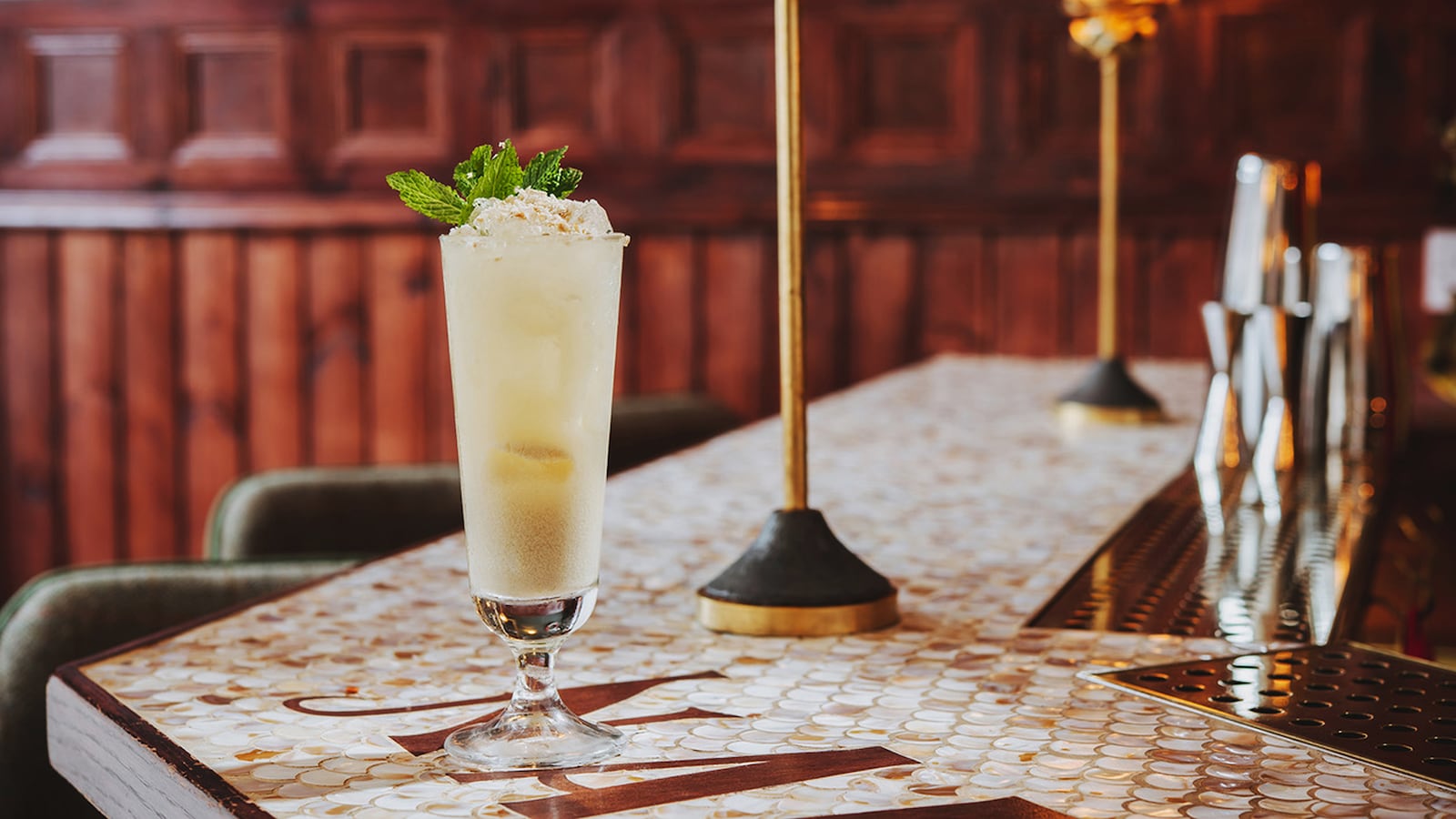Los Angeles’ Ambassador Hotel played host to every U.S. President from Hoover to Nixon, was the setting for six Oscar ceremonies and was infamously where Robert F. Kennedy was shot in 1968.
The establishment’s nightclub, the Cocoanut Grove, also played a small but significant role in the history of tiki cocktails.
A tropical oasis of remarkably realistic papier-mâché palm trees (transported directly from the set of silent movie, The Sheik, which starred Rudolph Valentino) lined a plush, grand dancehall that became a magnet for the most prestigious of L.A. society.

Night after night its dance floor was crowded with couples swaying to the rhythm of a live orchestra under a twinkling, star-studded blue ceiling. In its early years, the Grove was frequented by the likes of Charlie Chaplin, Clara Bow and, naturally, Valentino. At the height of its popularity in the 1930s, it became a hangout for Clark Gable, Katherine Hepburn and Cary Grant, among others. This was a place to see and be seen.
It was in its later years that the Grove established its place in the cocktail hall of fame. In 1962, award-winning bartender Tom Stenger introduced the Cocoanut Grove Cooler, a tiki cocktail made with tropical fruit juices, including pineapple, orange and passion fruit. The Grove described the bright, long drink on its menu as “a tall and colorful thirst quencher; to see it is to feel refreshed”–an appropriate fit for the tropical ambience of the club. What set the Cooler apart from the rest of tiki culture, which had been gaining momentum since its establishment in L.A. in the 1930s, was its spirit base–the Cocoanut Grove Cooler is one of the earliest known examples of Scotch tiki.

Traditionally, tiki is rum’s domain. When Louisiana native Donn Beach (A.K.A. Ernest Raymond Beaumont-Gantt) brought a slice of tropical Polynesia back to Hollywood in 1934 with the opening of Don the Beachcomber, he drew on the rums of the Caribbean.
“In the case of tiki’s progenitor, Don the Beachcomber, frugality was the mother of invention: he created rum tiki drinks because rum was cheaper than other base spirits,” says Jeff “Beach Bum” Berry, author, rum expert and owner of New Orleans’ bar Latitude 29. “Before Prohibition, no high-born drinker would touch rum, which was regarded as the drink of sailors and stewbums (Ernest Hemingway referred to alcoholics as ‘rummies’). During Prohibition, toffs deprived of their beloved whiskey and gin were forced to drink rum provided by Nassau rum-runners, but after Repeal nobody wanted the spirit anymore and it was available dirt cheap, as low as 70 cents a quart for excellent, aged Jamaican, Barbados and Demerara expressions.”
Combining local rum punch recipes with Polynesian tiki culture, Beach’s fresh, exotic and sweet “rhum rhapsodies” quickly caught on. Tiki bars began springing up all over the U.S. serving escapism in a glass, including, of course, the first outpost of Trader Vic’s in Oakland, California, in 1937.
While the category’s cocktails generally feature tropical fruits, a sweetening element, spices and rum with plenty of ice, often in colorfully elaborate mugs, there is no strict recipe that defines a tiki-style drink. And as the style evolved through the 1930s some bartenders began incorporating other spirits, either blending them together or forgoing the rum completely. The Fog Cutter, thought to have been created by Trader Vic Bergeron himself, contains a blend of rum, brandy and gin with lemon and orange juices, orgeat syrup and a cream sherry float. Unsurprisingly, many establishments allow customers to have just two of these powerful concoctions.
“The first bartenders that started making tiki [drinks] used different spirits in the beginning, mixing different rums and brandy, then rum and gin, then introducing sherry,” says Georgi Radev, co-owner of London bar Laki Kane. “Actually, there’s not a spirit that won’t work.”
Although Scotland can’t claim to be the world’s most exotic destination, Scotch whisky is inherently fruity, with some expressions dripping with tiki-sympathetic notes of pineapple, papaya, mango and citrus. While these flavors aligned with the premise of tropical escapism—not to mention the vanilla, coconut and Caribbean spices derived from the cask, there was another reason why Scotch was absent from tiki’s earliest best sellers.
By the time tiki was taking off in the States post-Prohibition, Scotch, being more expensive and difficult to procure—despite the scheming efforts of booze smugglers—had already cemented its reputation as an aspirational, quality spirit. Bartenders were hesitant to mix with it, favoring cheaper rum, and occasionally gin and bourbon. It’s the main reason why there are so few classic Scotch cocktails in general, despite being one of the most flavor-diverse spirits.
“Scotch in tiki drinks works,” explains Radev. “It’s just been put in the brains of people for so long that Scotch is not meant to be consumed in a long cocktail. It’s like no one really thought about using it, but it works really well.”
Just a handful of vintage Scotch-based tiki drinks are known to have existed, such as the London Sour, created for the 1963 opening of Trader Vic’s London outpost with orange, lemon juice and orgeat, and the Starboard Light, a twist on a Whiskey Sour made with passion fruit nectar.
With so few classics to lean on, Scotch is also largely absent from the recent tiki revival that’s been sweeping the U.S. and the rest of the world. But with a gradually changing mindset that yes, it’s OK to enjoy Scotch in a cocktail, the style is finding its way back onto menus in vintage and modern forms.

“I love that there are a few historic examples of Scotch tiki cocktails,” says Paul McGee, co-owner of Chicago’s Lost Lake. “It’s very unexpected; a lot of folks don’t think about using Scotch whisky in tiki applications or tropical drinks, but it can be a really fantastic pairing.” When Lost Lake opened in 2015 one of its most-ordered cocktails was the Cocoanut Grove Cooler. Five years later the bamboo-decked urban oasis still features the drink as one of only three reimagined tiki classics. “The versatility of the category of Scotch whisky can really bring out some different flavors in tropical cocktails,” McGee adds. The bar uses five-year-old blended Scotch Bank Note in its Cooler recipe for its youthfulness, which “works well with citrus.” While blends, like Bank Note, that have a high grain content, provide a light, delicately fruity canvas to color with vibrant tropical flavors, different styles of Scotch can take tiki into unchartered territory.
For James Sutter at Boston’s Baldwin Bar, Speyside single malt Glenfiddich 14-Year- Old is a perfect balance of fruit and oak spice that pairs harmoniously with the exoticism of tiki. “The spicier notes work really well with tiki flavors,” he says. “Scotch really should be in more tiki drinks; besides the high acid content of tiki drinks, they are also spicy. They have lots of baking spice notes—cinnamon, vanilla, nutmeg—which are all classic tiki ingredients and certainly things you can find in some Scotches.”
The bar, a world-class mahogany-decked hangout secreted inside Boston’s Sichuan Garden II Chinese restaurant, often partners Scotch with a fatty modifier, like butter syrup or orgeat, to soften any tannic notes in the whisky. The Baldwin even has a house-made coconut oil, made from coconut water, fat and pulp with sugar and three-year-old El Dorado Rum, which is emulsified into the Scotch. “It’s an extremely flavorful body-enhancing coconut syrup,” Sutter exclaims.
When working with peated Scotch, Laki Kane’s Radev recommends waiving some traditional tiki ingredients, such as passion fruit, that might clash. Instead, he says, find flavors that have a natural affinity to one another. “Smoky whisky works really well with spice, so maybe use gardenia mix (a typical tiki ingredient with butter, honey and spices),” he says, referencing a past Laki Kane cocktail called the Scottish Pearl Diver, which contained rum, Lagavulin, gardenia mix, mandarin and fresh lime.
Scotch-based tiki and tropical cocktails are slowly making their way onto the menus of some of the world’s best bars, though it’s a process hampered by the spirit’s lingering reputation as a sophisticated sipper, one which jars with tiki’s perceived flamboyancy. For Kyle Jamieson, who co-owns Nauticus in Leith, Scotland, the style represents an opportunity to have a bit of fun. He says the bar’s Porridge Colada, made with coconut-washed Shackleton Blended Malt Whisky, oat milk, local honey and pineapple juice “makes people smile.”
“People are intrigued by it,” he says. “Especially on Leith, no one’s seen a Porridge Colada before. It’s a fun interpretation and a lighter, fresher colada-style drink.”
Could tiki and tropical cocktails be the tonic Scotch needs to shake its stiff image? “It can’t be a passing fad if it’s delicious,” explains Boston’s Sutter. “We just need to find the right combinations of flavors and ingredients. People are already understanding the flavor we commonly associate with tiki is not restricted to rum, and as part of that evolution people realize that Scotch works, too.”
By Paul McGee, Lost Lake
INGREDIENTS:
- 1.5 oz Bank Note Scotch
- .5 oz Batavia Arrack
- .75 oz Pineapple juice
- .75 oz Lemon juice
- .5 oz Passion fruit syrup
- .5 oz Pierre Ferrand Dry Curacao
- .25 oz Orgeat
- .25 oz Pomegranate syrup
- Glass: Parrot mug
- Garnish: Pineapple fronds, an orchid, an orange floret and a parasol
DIRECTIONS:
Add all the ingredients to a shaker and fill with ice. Shake, and strain into a parrot mug filled halfway with fresh ice cubes. Top with crushed ice and garnish with pineapple fronds, an orchid, an orange floret and a parasol.
This recipe is adapted from Tom Stenger’s award-winning 1962 recipe served at the Cocoanut Grove in Los Angeles.
By Paul McGee, Lost Lake
INGREDIENTS:
- 1.5 oz Bank Note Scotch
- 3 dashes Laphroaig 10-Year-Old Scotch Whisky
- .75 oz Lemon juice
- .5 oz Orgeat
- .25 oz Pierre Ferrand Dry Curacao
- .25 oz Cane Syrup
- Glass: Mai Tai glass
- Garnish: A large bouquet of mint, an orange floret and a parasol
DIRECTIONS:
Add all the ingredients to a shaker and fill with ice. Shake with ice for 5 seconds, and strain into a Mai Tai glass filled halfway with fresh ice cubes. Top with crushed ice and garnish with a large bouquet of mint, orange floret and parasol.
This drink is adapted from Trader Vic’s original 1963 recipe.

